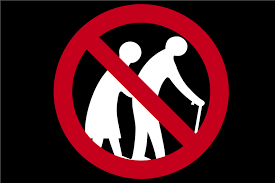 What is the point of sneering at older people? Rant on. Consider an upcoming HIMSS event in Orlando with the charming title: Monitoring Grandma: Adoption of Connected Health Tech by Seniors. That version of the title is spelled out here because the presenter has been alerted and agreed that the title was condescending – so MAYBE it will be changed. But this is just the tip of the condescension iceberg: Go ahead, Google ‘technology grandma’. Just check out the first page or two of the millions of identified references – including the images of older women ‘holding it wrong’ or ‘ confused.’ No wonder HIMSS session folks thought this was no big deal.
What is the point of sneering at older people? Rant on. Consider an upcoming HIMSS event in Orlando with the charming title: Monitoring Grandma: Adoption of Connected Health Tech by Seniors. That version of the title is spelled out here because the presenter has been alerted and agreed that the title was condescending – so MAYBE it will be changed. But this is just the tip of the condescension iceberg: Go ahead, Google ‘technology grandma’. Just check out the first page or two of the millions of identified references – including the images of older women ‘holding it wrong’ or ‘ confused.’ No wonder HIMSS session folks thought this was no big deal.
Despite the user interface complexity, smartphone adoption by seniors is rising. Pew hasn’t bothered lately, but AARP recently published a survey of tech ownership among the 50+. This time the breakdown included age 70+ as a segment in which 62% own a smartphone. Not too surprising, when you consider that the neighborhood store display of feature phones for Verizon has, uh, shrunk to just one. Meanwhile, the average age of a first time grandparent in the US is 50 and by age 65, according to AARP data, 96% are grandparents. Think of that as you study the Shutterstock images of what grandma presumably looks like.
Back to monitoring, connected health or otherwise. Because technology can be used for a purpose, inventors want to make it so. Sensor-based home monitoring was a 2007-ish innovation. Perhaps they had or have a grandmother who fell down and want to launch a new tech to prevent others from having a similar experience. This is laudable. Telehealth was a pioneering concept in 2008. In 2020, telehealth (and its other prefixes or monikers) is an accepted service with reimbursement codes. Yet adoption is slow – reasons are many. One of them surely has to do with the willingness of the older person to be monitored, unless required. How do tech firms and insurers overcome this reluctance? With persuasion?
The home visit – no tech result, interesting motive. Meanwhile, Medicare Advantage plans telemarket home nurse visits which provide an opportunity to assess risk scores, enabling them to boost insurer reimbursements from Medicare based on that assessment, independent of whether the insured has already been assessed at the doctor’s office. Do these visits result in recommendations for telehealth? No – since they are independent of patient care. The 2017 Harvard article indicates that 1 million had signed up for these home nurse visits – but there were 19 million people covered by Medicare Advantage plans in 2017. That’s 5 percent! That means most people said no, sometimes repeatedly, to aggressive telemarketing efforts. Perhaps grandma may not want to be checked up on, that is, monitored, either by 'connected health' or other forms of oversight that does not demonstrate clear benefit to the individual being monitored – and without the all-important 'Opt in.' Perhaps marketers of tech intended to monitor older adults could include something of benefit for them? How about free Wi-Fi and a smart speaker? Just saying. Rant off.
from Tips For Aging In Place https://www.ageinplacetech.com/blog/why-are-older-adults-demeaned-health-and-tech-industry
No comments:
Post a Comment
Note: Only a member of this blog may post a comment.